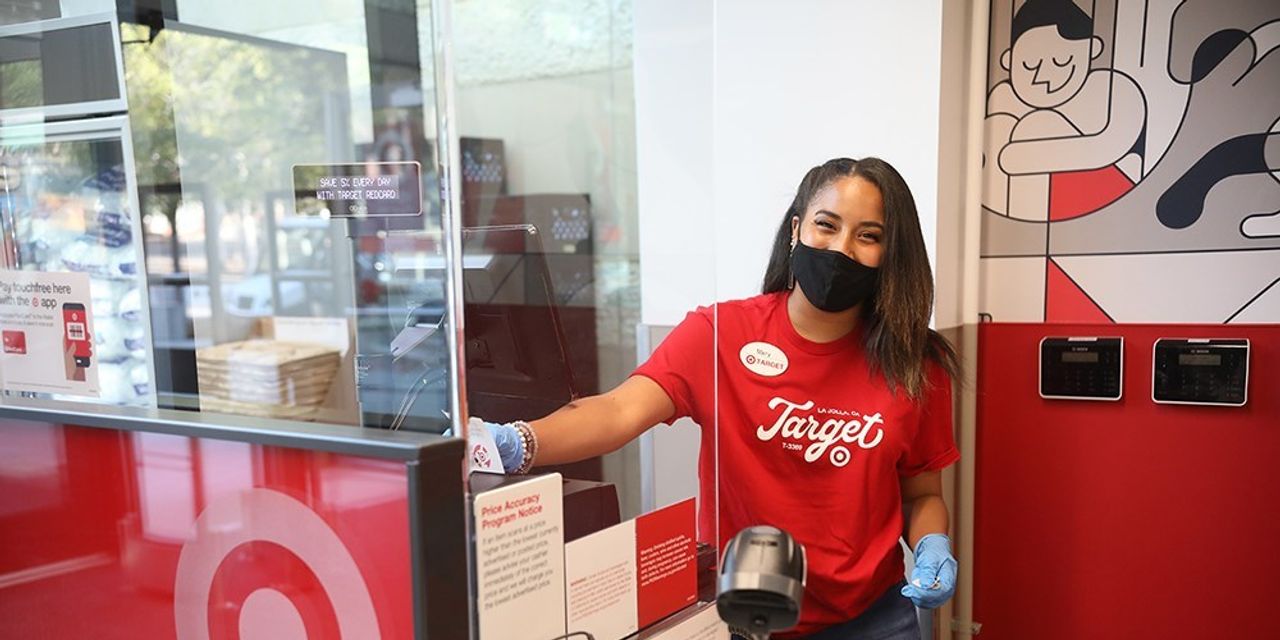
Target Corp. TGT, +1.16% will be hanging on to the safety measures implemented during the pandemic for the foreseeable future, Chief Executive Brian Cornell told reporters recently.
“The focus on safety will be with consumers for years to come,” he said. “We will continue to lean into ensuring a safe, contact-free environment. The plexiglass will stay up for a while, and we will continue to encourage social distancing.”
Still, Target is preparing for the day when shoppers will return to some of their pre-pandemic behaviors, like lingering in stores to see what’s new and exciting, rather than popping in simply to pick up an order placed online.
“We’re preparing for a guest that will take more time to shop the whole store. We expect to see many of the impulse items continue to grow as guests take more time,” he said.
As people start “getting out of yoga pants,” and begin shopping for parties, events and luggage they need for the increased amount of time spent outside of the home, Target says the renewed activity “will add vibrancy to certain parts of the assortment.”
The COVID-19 pandemic isn’t over yet, but one year in, vaccines are rolling out, travel plans are being made and, for some, it’s party time.
Also: ‘I don’t think these are college kids’: Miami mayor warns people against descending on Florida
For most others, it’s still a time to be cautious even as the dim light at the end of the pandemic shines a little brighter.
According to the American Psychological Association’s “Stress in America” report that looks at the pandemic one year later, 57% of Black Americans say they “feel
uneasy about adjusting to in-person interaction once the pandemic ends.” Fifty-one percent of Asian Americans, 50% Hispanics and 47% white Americans feel the same way.
And nearly half of Gen Z adults (46%) say their mental health has worsened, followed by Gen Xers (33%), millennials (31%), boomers (28%) and older adults (9%).
Despite the heightened feelings of stress, Stephen Rogers, executive director of the Deloitte Insights Consumer Industry Center, says it’s an evolving situation.
Read: Target to spend $4 billion annually over the next several years to build on ‘record breaking’ 2020
“It has taken a year of psychic scarring to get to this point,” he told MarketWatch. “But stories of people gathering, congregating in larger sizes – once that starts happening, I think consumer confidence about getting out and about will continue to grow.”
Deloitte data released on Monday shows that anxiety levels are starting to decline, with 64% of people in the U.S. feeling safe to go to stores, up from 51% in late December.
“In the U.S., nearly as many surveyed consumers are worried about contracting COVID-19 as they are about their finances (51% and 48% respectively),” the Deloitte report said.
And more people are making plans to spend money on clothes and dining out, even if one in three say they will wait until after the pandemic to take a vacation.
Google’s GOOG, +0.85% GOOGL, +0.77% most recent COVID-19 Community Mobility Report shows that visits to places like restaurants, shopping centers, theme parks and museums in the U.S. is down just 10% from pre-COVID levels.
“What we’re telling retailers and what they’re telling us is the need to be much more granular in their understanding of the consumer,” said Anthony Waelter, US consumer industry leader at Deloitte LLP.
“They need to deepen empathy with consumer – a recognition that there are diverse perspectives about physical and financial well-being.”
Watch: 3 ways the role of TV changed in the pandemic
Mask-wearing is likely to stick around as will social distancing and other safety measures that consumers have grown familiar with. But now, Rogers says, retailers need to “strike the balance” between being cautious and moving forward as people become more comfortable with activities that will place them back in public spaces.
One thing that isn’t going away is online shopping, which was growing before COVID-19 and accelerated during the pandemic. Both Rogers and Waelter say the surge in e-commerce began as a safety measure and has become an issue of convenience.
The key now is to evolve stores and the shopping experience into one that the consumer can enjoy with ease, whether they’re roaming the aisles, picking up an order, or trying to return an item.
“The role of the store and the associates will be reimagined,” said Rob Garf, retail vice president and general manager at Salesforce.
Also: Walmart adding dozens of automated local fulfillment centers to speed delivery and pickup orders
Don’t miss: Nordstrom launches Livestream Shopping with Burberry event
Stores have been turned into mini-fulfillment centers and have shifted their physical layouts with smaller formats or shop-in-shop setups on the horizon; associates have taken on new roles as service agents and other duties; and brick-and-mortar locations have become increasingly contactless.
“There have been many turns that retailers have had to make over the last 12 months, and they were forced to rethink the role of the store, which they’ve been dabbling in in the last decade, but COVID has accelerated it,” Garf said.
Garf is forecasting shopper hesitance to go back to stores in great numbers during the first half of the year, but demand will drive shoppers out during the second half.
Salesforce is talking with clients now about handling that increasing volume in terms of both safety and in the quality of experience. After all, people will be going to stores not just to buy things but to have fun in all the ways that the pandemic has curtailed.
“What consumers are craving is experience, and that spans all aspects of someone’s life,” he said.
“Whether entertainment, or travel or dining, there’s this pent-up need for experience. That’s likely what will motivate people to get back to the store.”






